Comparing Twitter activity from different LIS conferences: current observations and future research directions
Dan Albertson.
Introduction. Twitter activity from different 2018 library and information science (LIS) research conferences are analysed, compared, and reported.
Method. Twitter activity was collected after three 2018 LIS research conferences. The conferences included the Annual Meeting of the American Society for Information Science and Technology, the ACM/IEEE Joint Conference on Digital Libraries, and the Libraries in the Digital Age conference.
Analysis. Twitter data elements were collected and analysed, which included the number of original tweets, retweets, likes, and unique users. Other derived counts were tallied for the number of original tweets and retweets (as combined), likes and retweets (as combined), the number of tweets that were retweeted, and all actions combined.
Results. The levels of activity across each of these elements and counts are presented overall and based on different time-points during the conferences. Results are combined across the three conferences and presented separately.
Conclusion. Social media at academic conferences provides for a unique and important context of scholarly communication. It is important to understand the nature of such communications that occur online during academic conferences and the eventual impact on scholarly and professional movements. Opportunities remain for further in-depth studies of social media use at academic conferences and its broader implications for scholarly communication.
Introduction
Social media is a regular topic in scholarly communication research. Here, social media has been studied by type of platform, as a source of data or information, its ethical and/or policy implications, its users and uses, and the role and impact on alternative bibliographic metrics (i.e. “altmetrics”) (Sugimoto et al., 2017).
Academic conferences and social media – together – have also been studied and described (Chung & Woo, 2016; Ferguson et al., 2014; Holmberg & Thelwall, 2014; Kimmons & Veletsianos, 2016; Reinhardt et al, 2009). Microblogging sites such as Twitter are used to converse online about the events and content of academic conferences. As such, most academic conferences these days delegate a standardized hashtag so that posts (e.g. tweets) can be aggregated into conversations around the conference. These online conversations are forms of scholarly communication, and findings on social media use at academic conferences has been reported across diverse domains and disciplines, including education, cardiology, urology, and others (Chung & Woo, 2016; Ferguson et al., 2014; Holmberg & Thelwall, 2014; Kimmons & Veletsianos, 2016). The intersection of scholarly communication, social media, and the academic conference together provides for an important and unique context, comprised of interactions and online conversations among scholars in a highly condensed window of time. The visible role that social media now plays at academic conferences warrants further research and thus a better understanding of the interactions and communications between scholars.
Research objective
The primary research objective of the study is to report on social media use and activity from three library and information science (LIS) research conferences. The conferences included the 2018 Annual Meeting of the American Society for Information Science and Technology (ASIS&T), the 2018 ACM/IEEE Joint Conference on Digital Libraries (JCDL), and the 2018 Libraries in the Digital Age (LIDA) conference. As such, the study also provides a set of measures that can be used to analyse social media activity at future academic conferences and ideas for broader more in-depth studies of its impact.
Related research
Social media’s function as a channel for scholars and researchers to communicate across different platforms and media has been recognized (Sugimoto et al., 2017). Further, scholars from diverse disciplinary areas employ social media for a range of research-related activities, spanning research dissemination and promotion, collaboration, coordination, and many other tasks (Rowlands et al, 2011).
Academic conferences have also adopted and employed social media for diverse purposes. Similar to the goals of the present study, Twitter usage has been reported throughout different time points of academic conferences, including the levels of activity over different days and times (Gonzales, 2014). Additionally, conferences from broad academic disciplines have been summarized, compared (Mahrt, Weller, & Peters, 2014; Parra et al., 2016), and analysed longitudinally, including over multiple years (Parra et al., 2016; Wen et al., 2014). Prior studies have allowed researchers to compare and contrast Twitter activities from different individual conferences over time (Wen et al., 2014).
Research about social media and academic conferences has expanded beyond descriptive findings of activity levels. Themes and/or types (i.e. categories) of conversations, interactions, and users have provided insights into the nature of the discourse occurring \ on social media during academic conferences. For example, categories of researchers, grouped by stage of their career and work context, have been compared according to their contributions to the online conversations and subsequently the attention they receive from other users (e.g. researchers) in return (Wen, Parra, & Trattner, 2014).
Content and semantic analyses of conversations from conferences have also been conducted. Based on term occurrences, topics of conversations occurring on Twitter during different computer science conference were previously reported (Parra et al., 2016). In addition, analysis of hashtag adoption has been used to indicate the types of conversations or movements emerging from conferences. Conversations from conferences which are not necessarily academic in nature have been described; the conversations themselves have been portrayed as complex, sometimes noisy, and not always focused on the academic content or themes of the conference (Ross et al., 2011). Interactions and exchanges have also been shown to vary by language in how tweets in certain languages reference tweets and users of other languages (Garcia et al., 2015).
Existing research on social media and scholarly communication is broad and deep. Therefore, the range of literature pertaining to social media and academic conferences is also quite diverse, which indicates its relevance and significance as a contemporary area of research. Examining disciplinary aspects of social media use is significant for understanding the communications among different groupings of scholars.
Data collection
Twitter use at academic conferences is the focus of the present study. Twitter is widely used by conference attendees and other users for posting (i.e. tweeting) and conversing online about activities and content from academic conferences. Data (and metadata) of the Twitter activity that occurred before, during, and after the three LIS academic conferences were collected. Findings here depict scholarly communication centred around a particular academic event in a highly condensed timeframe.
The Twitter4J API was used to build an application that collected data by searching the conference hashtags (e.g. “#ASIST18”). These Twitter data were analysed in ways to achieve the research objectives of the study.
Data analysis
Data elements of tweets were used to form different variables (or units) for analysis. The variables were based on both primary and aggregated (i.e. derived) Twitter data elements. Definitions of the primary variables as examined in the study included:
- Original tweet: Non-retweet (RT), an original post/tweet by a user
- Retweet (RT): A RT of a tweet, identified as “true” within the RT data element
- Original tweet and retweet (combined): Sum of tweet and RT counts
- Like: A count of likes of original tweets
- Secondary action: Sum of likes and RTs
- Tweet retweeted: A count of original tweets that were retweeted
- Overall actions: Sum of original tweets, RTs, and like counts
- Unique users: A distinct user (ID), whether of an original tweet or RT (users of likes are not accessible through the Twitter4J API)
Analysis of these variables included counts overall and by comparison across different time-points or days within the conference (from pre- to post-conference).
Findings
Results of the study are presented in Figures 1-8 and Table 1. In total, 4,210 actions were analysed, including 327 unique users as identified in the data, across the three conferences.
First reported are the results for the different types of Twitter activities. Overall counts for the Twitter actions (as listed above) are shown in Figure 1.
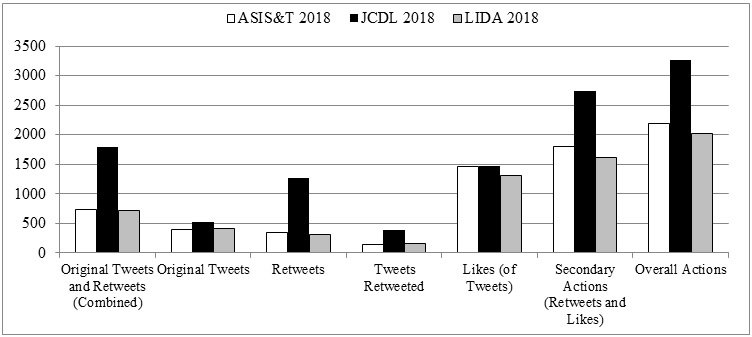
Next, the number of actions is reported across different days of the conference (see Figures 2-6)
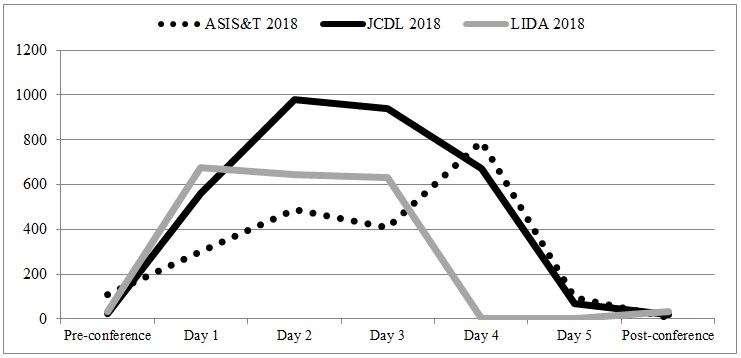
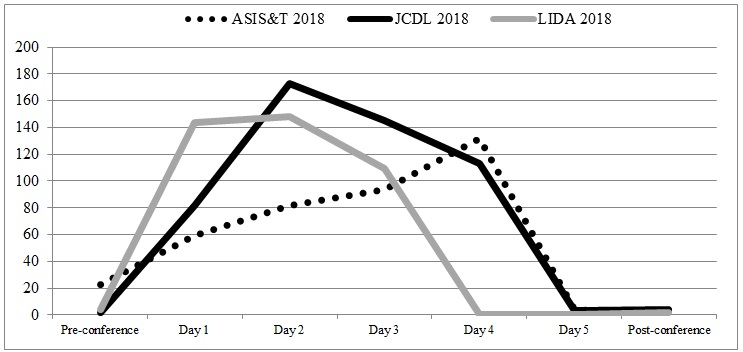
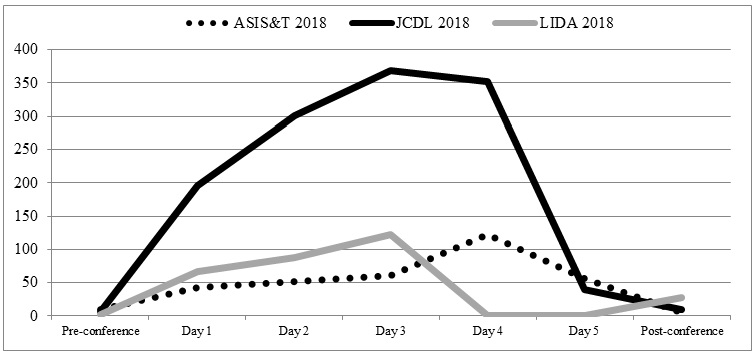
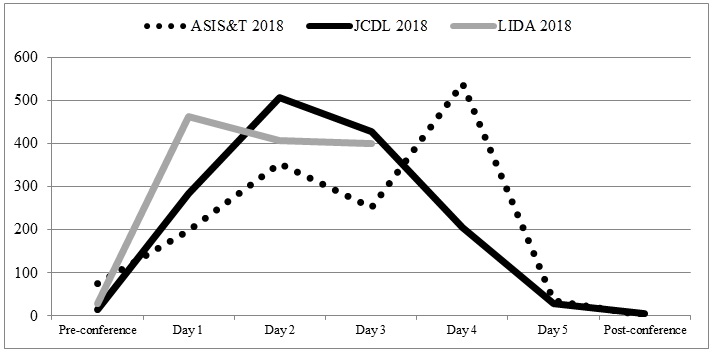
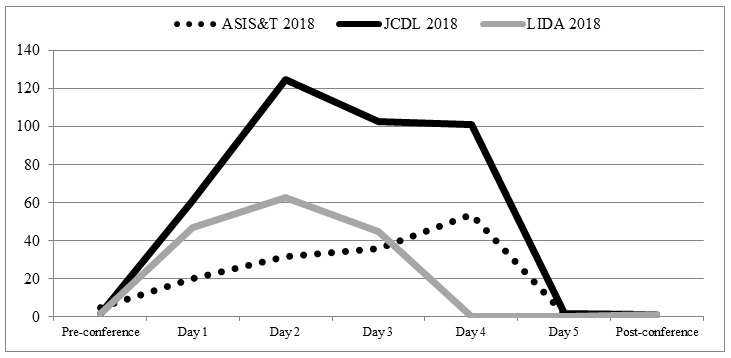
Counts for the different categories of users are reported in Figures 7 and 8; these include the number of users who had original posts versus those who retweeted. These results are also reported overall (Figure 7) and by day of the conference (Figure 8).
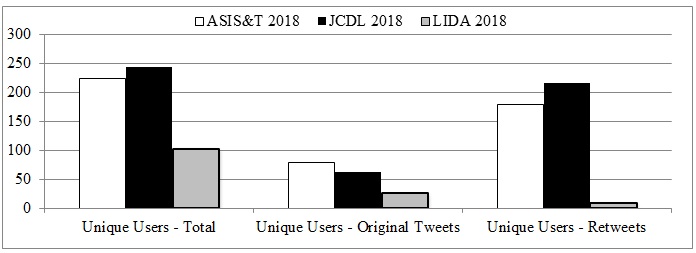
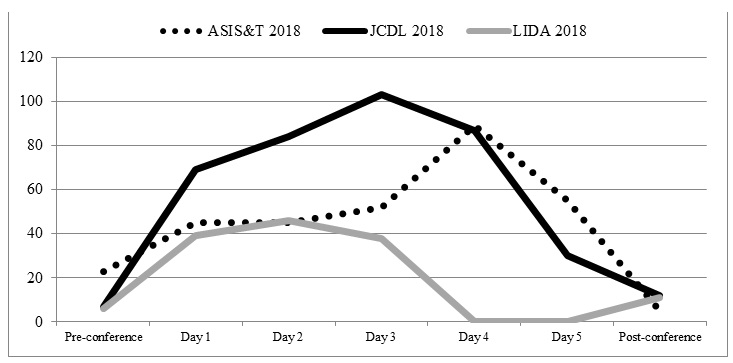
Descriptive results on the number of tweets and retweets by user are shown in Table 1; these results are adjusted for the number of users identified for each respective conference.
| ASIS&T 2018 | JCDL 2018 | LIDA 2018 | |
| Mean | 3.31 | 7.32 | 6.91 |
| Median | 1.00 | 1.00 | 1.00 |
| Std. Deviation | 9.170 | 30.433 | 22.801 |
| Range | 122 | 335 | 182 |
| Minimum | 1 | 1 | 1 |
| Maximum | 123 | 336 | 183 |
The results presented here show different levels of Twitter activities and numbers of users participating in the online conversations overall, across different time points in the conference, and as normalized by numbers of unique users.
Discussion of the Results
The study provides insight about the different types of Twitter activity occurring throughout various conferences within our own discipline. First, the patterns of Twitter activity – generally speaking – as observed across all three conferences were similar. There was a clear (and obvious) flurry of activity during the actual days of the conference. Far fewer users and actions were observed pre- and post-conference; the intense activity started at the first day of the conferences, and activity almost instantly and completely declined afterwards. There were similar numbers of Twitter users during the ASIS&T and JCDL conferences, and substantially fewer users tweeting about the LIDA conference, which is sensible considering it was the smallest (attendance-wise) of the three.
One distinction within the results pertained to the number of retweets across the different conferences. Furthermore, the Twitter activity during JCDL showed a much larger number of retweets, despite not having a much larger number of user participants. Further research can examine how this finding can serve as an indicator.
The number of overall actions also showed some interesting findings. While the user numbers were substantially lower for those participating in LIDA discussions, the overall number of observed actions kept pace with ASIS&T, a larger, lengthier, and older field-wide conference. This finding suggests that averages are not the most insightful statistic in this context, particularly considering the medians and standard deviations of the Twitter actions. The standard deviations and medians (all = 1) for the three conferences (Table 1) show that the vast majority of the users within the dataset performed only one action (either a tweet or retweet). In fact, the percentage of users with only 1 logged action across the 3 conferences ranged from 57%-67%, while the percentage of users with 50 or more actions ranged from only 3.9% to 0.4%. The actions of users – at least in terms of the numbers of original tweets and retweets – were unbalance or not evenly distributed. This finding is sensible as not everyone involved in the discussions would be onsite and perhaps would be more casual observers (based on the topics that interest them individually). The “heavy lifters” would need to be verified as actual conference attendees.
These findings, while descriptive at this stage in the analysis, can still indicate a number of practical insights and suggestions of how future research can move forward.
Practical implications and future directions
The present study provides understanding of the online Twitter activities occurring during several important LIS research conferences. As part of this research, observations of the practical implications for using APIs to acquire Twitter data for researching scholarly communications at academic conferences have been made and are reported here to support future studies. These include:
- Datasets of this nature (e.g. from proprietary sources and that require manual tagging by users) present limitations in terms of what data are possible of being collected and thus analysed. E.g. if a Twitter application searches by hashtag, there may be original tweets or RTs from conference attendees and/or other participants in the conversations that may be missed if not manually included.
- The Twitter4J API limits the number of tweets and metadata capable of being searched via applications. Tweet downloads are capped both in 15 minute intervals (max of 100) and are only accessible through applications in a seven-day window.
- Only counts of likes of tweets are accessible through a search with the API, not usernames/IDs of those who like a post. Aspects such as these provide certain limitations for more fully examining topics such as interdisciplinary reach.
Next, the study can suggest ways in which researchers can analyse social media activities from academic conferences more broadly or extensively as measures of scholarly communication. As such, a number of future research opportunities can be suggested including (but not limited to):
- Combining analysis of social media activity at academic conferences with other metrics in longitudinal approaches to assess the impact of the academic conference (and its content) on ensuing scholarly communications.
- Examining how social media data from academic conferences can serve as an indicator of the reach of conferences and perhaps the larger discipline(s).
- Examining different inner- or sub-disciplinary focused LIS conferences (or another academic filed) to draw comparisons of Twitter trends based on the research interests and backgrounds of the attendees.
With Twitter use at academic conferences being such a unique context of scholarly communication, it is important to better understand how innovations and controversies appearing at conferences – as indicated by social media activity – impact progress and future research. Studies such as this provide a starting point and emphasis for initiating further research and are therefore significant for scholarly communications.
About the author
Dan Albertson works at University at Buffalo, The State University of New York. Interactive video retrieval has been his primary research area. His research projects have examined: user interaction with video digital libraries, human factors affecting interactive video retrieval, and video and visual information seeking. Some new and future research directions of his include: digital video content curation, cultural competency and digital content, STEM learning in library spaces, and social media and scholarly communications. He can be contacted at dalbert@buffalo.edu.
References
- Chung, A. & Woo, H. (2016). Twitter in surgical conferences. ANZ Journal of Surgery, 86(4), 224-227.
- Ferguson, C., Inglis, S. C., Newton, P. J., Cripps, P. J., Macdonald, P. S. & Davidson, P. M. (2014). Social media: A tool to spread information: a case study analysis of Twitter conversation at the Cardiac Society of Australia & New Zealand 61st annual scientific meeting 2013. Collegian, 21(2), 89-93.
- Garcia, R., Gómez, D., Parra, D., Trattner, C., Kaltenbrunner, A. & Graells-Garrido, E. (2015, August). Language, Twitter and academic conferences. In Proceedings of the 26th ACM conference on hypertext & social media (pp. 159-163). New York, NY: ACM.
- Gonzales, L. (2014, September). An analysis of Twitter conversations at academic conferences. In Proceedings of the 32nd ACM International Conference on The Design of Communication CD-ROM (p. 4). New York, NY: ACM.
- Holmberg, K. & Thelwall, M. (2014). Disciplinary differences in Twitter scholarly communication. Scientometrics, 101(2), 1027-1042.
- Kimmons, R. & Veletsianos, G. (2016). Education scholars’ evolving uses of Twitter as a conference backchannel and social commentary platform. British Journal of Educational Technology, 47(3), 445-464.
- Mahrt, M., Weller, K., & Peters, I. (2014). Twitter in scholarly communication. Twitter and society, 89, 399-410.
- Parra, D., Trattner, C., Gómez, D., Hurtado, M., Wen, X. & Lin, Y. R. (2016). Twitter in academic events: a study of temporal usage, communication, sentimental and topical patterns in 16 computer science conferences. Computer Communications, 73, 301-314.
- Reinhardt, W., Ebner, M., Günter, B. & Costa, C. (2009). How people are using Twitter during conferences. In (Eds.) Hornung-Prähauser, V., Luckmann, M., Creativity and Innovation Competencies on the Web. Proceedings of the 5th EduMedia Conference (pp. 145-156).
- Ross, C., Terras, M., Warwick, C. & Welsh, A. (2011). Enabled backchannel: Conference Twitter use by digital humanists. Journal of Documentation, 67(2), 214-237.
- Rowlands, I., Nicholas, D., Russell, B., Canty, N. & Watkinson, A. (2011). Social media use in the research workflow. Learned Publishing, 24(3), 183-195.
- Sugimoto, C. R., Work, S., Larivière, V., & Haustein, S. (2017). Scholarly use of social media and altmetrics: A review of the literature. Journal of the Association for Information Science and Technology, 68(9), 2037-2062.
- Wen, X., Lin, Y. R., Trattner, C. & Parra, D. (2014, September). Twitter in academic conferences: Usage, networking and participation over time. In Proceedings of the 25th ACM conference on Hypertext and social media (pp. 285-290). New York, NY: ACM.
- Wen, X., Parra, D. & Trattner, C. (2014, February). How groups of people interact with each other on Twitter during academic conferences. In Proceedings of the companion publication of the 17th ACM conference on Computer supported cooperative work & social computing (pp. 253-256). New York, NY: ACM.